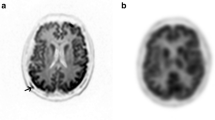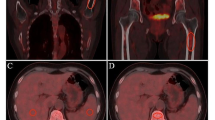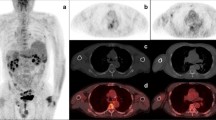Abstract
Whole-body scintigraphy with Technetium-99m 2-methoxy-isobutyl-isonitrile (99mTc-MIBI) has been proposed as a useful method for demonstrating the areas of active bone marrow infiltration in multiple myeloma (MM). In this study, we compared the 99mTc-MIBI scan with magnetic resonance imaging (MRI), skeletal X-ray survey, and biochemical markers of disease activity in MM to determine its potential in predicting the extension of the disease. Twenty-four myeloma patients had undergone to the 99mTc-MIBI scan. Only two patients showed negative results in the 99mTc-MIBI scan; one had clinically active disease, and the other was on remission. MRI was performed to 18 clinically active patients, and 16 of them showed positive myelomatous bone marrow involvement. No significant difference was found between the 99mTc-MIBI scan and MRI in predicting the extension of bone marrow infiltration in MM (p = 0.11). 99mTc-MIBI scores were correlated with bone marrow neoplastic plasma cell ratio (p = 0.005), serum paraprotein level (p < 0.001), serum lactate dehydrogenase (p = 0.031), and beta-2 microglobulin (p = 0.045). The 99mTc-MIBI scan showed disease activity better than the skeletal X-ray survey (x 2 = 5.299, p = 0.021). A significant decrease was found in posttreatment 99mTc-MIBI scores of the patients with positive overall response (p = 0.016). The 99mTc-MIBI scan is a noninvasive test that can show the extension of the disease in MM. It seems that the 99mTc-MIBI scan and MRI show extension and intensity of the myelomatous bone marrow infiltration equally well. The 99mTc-MIBI scan can be an alternative to MRI when it is not available or if there is any limitations for its usage.





Similar content being viewed by others
References
Ak I, Aslan V, Vardareli E, Gulbas Z (2003) Tc-99m methoxy isobutylisonitrile bone marrow imaging for predicting the levels of myeloma cells in bone marrow in multiple myeloma: correlation with CD38/CD138 expressing myeloma cells. Ann Hematol 82:88–92
Alexandrakis MG, Kyriakou DS, Passam FH, Malliaraki N, Christophoridou AV, Karkavitsas N (2002) Correlation between the uptake of Tc-99m-sestaMIBI and prognostic factors in patients with multiple myeloma. Clin Lab Haematol 24:155–159
Attal M, Harousseau JL, Stoppa AM, Sotta JJ, Fuzibet JG, Rossi JF, Cassassus P, Maissonneuve H, Facon T, Ifrah N, Payen C, Bataille R (1996) A prospective randomized trial of autologous bone marrow transplantation and chemotherapy in multiple myeloma. N Engl J Med 335:91–97
Bacovsky J, Scudla V, Myslivecek M, Nekula J, Vytrasova M (2005) Scintigraphy using (99 m)Tc-MIBI (sestamibi), a sensitive parameter of activity of multiple myeloma. Neoplasma 52:302–306
Baur-Melnyk A, Buhmann S, Durr HR, Reiser M (2005) Role of MRI for the diagnosis and prognosis of multiple myeloma. Eur J Radiol 55:56–63
Catalano L, Pace L, Califano C, Pinto AM, De Renzo A, Di Gennaro F, Del Vecchio S, Fonti R, Salvatore M (1999) Detection of focal myeloma lesions by technetium-99 m-sestaMIBI scintigraphy. Haematologica 84:119–124
Del Vecchio S, Ciarmiello A, Pace L, Potena MI, Carriero MV, Mainolfi C, Thomas R, D’Aiuto G, Tsuruo T, Salvatore M (1997) Fractional retention of technetium-99 m-sestamibi as an index of P-glycoprotein expression in untreated breast cancer. J Nucl Med 38:1348–1351
Durie BGM, Salmon SE (1975) A clinical stating system for multiple myeloma. Cancer 36:842–854
Durie BGM, Waxman A, Jochelson M, Giles FJ, Hamburg S, Avedon M (1994) Technetium-99m-MIBI scanning in multiple myeloma. Proc Am Soc Clin Oncol 13:411a
Durie BGM (2006) The role of anatomic and functional staging in myeloma: description of Durie/Salmon plus staging system. Eur J Cancer 42:1539–1543
Fonti R, Del Vecchio S, Zannetti A, De Renzo A, Di Gennaro F, Catalano L, Califano C, Pace L, Rotoli B, Salvatore M (2001) Bone marrow uptake of 99mTc-MIBI in patients with multiple myeloma. Eur J Nucl Med 28:214–220
Lindstrom E, Lindstrom FD (1980) Skeletal scintigraphy with technetium diphosphonate in multiple myeloma—a comparison with skeletal X-ray. Acta Med Scand 208:289–291
Mirzaei S, Filipits M, Keck A, Bergmayer W, Knoll P, Koehn H, Ludwig H, Pecherstorfer M (2003) Comparison of Technetium-99m-MIBI imaging with MRI for detection of spine involvement in patients with multiple myeloma. BMC Nucl Med 3:2
Moulopoulos LA, Varma DG, Dimopoulos MA, Leeds NE, Kim EE, Johnston DA, Alexanian R, Libshitz HI (1992) Multiple myeloma: spinal MR imaging in patients with untreated newly diagnosed disease. Radiology 185:833–840
Moulopoulos LA, Dimopoulos MA (2004) Radiologic features of multiple myeloma. In: Malpas JS, Bergsagel DE, Kyle RA, Anderson KC (eds) Myeloma biology and management, 3rd edn. Elsevier, USA, pp 175–185
Otsuka N, Fukunaga M, Morita K, Ono S, Nagai K, Yamada O, Yawata Y (1993) Bone and 67Ga scintigraphy in the evaluation of rib lesions in patients with multiple myeloma. Radiat Med 11:75–80
Pace L, Catalano L, Pinto AM, Renzo A, Di Gennaro F, Califano C, Del Vecchio S, Rotoli B, Salvatore M (1998) Different patterns of technetium-99 sestamibi uptake in multiple myeloma. Eur J Nucl Med 25:714–720
Tirovola EB, Biassoni L, Britton KE, Kaleva N, Kouykin V, Malpas JS (1996) The use of 99mTc-MIBI scanning in multiple myeloma. Br J Cancer 74:1815–1820
Vande Berg BC, Lecouvet FE, Michaux L, Ferrant A, Maldague B, Malghem J (1998) Magnetic resonance imaging of the bone marrow in hematological malignancies. Eur Radiol 8:1335–1344
Author information
Authors and Affiliations
Corresponding author
Rights and permissions
About this article
Cite this article
Erten, N., Saka, B., Berberoglu, K. et al. Technetium-99m 2-methoxy-isobutyl-isonitrile uptake scintigraphy in detection of the bone marrow infiltration in multiple myeloma: correlation with MRI and other prognostic factors. Ann Hematol 86, 805–813 (2007). https://doi.org/10.1007/s00277-007-0329-z
Received:
Accepted:
Published:
Issue Date:
DOI: https://doi.org/10.1007/s00277-007-0329-z




